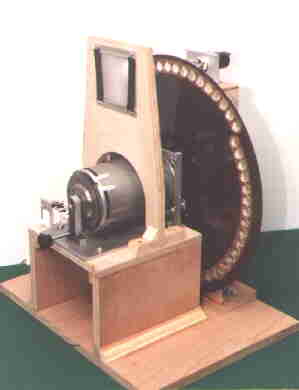|
Television Experimenters.com
Lens Disk
Lens Disks
n early improvement over the Nipkow disk was the lens disk. It was much more efficient in that lenses could pass many times more light compared to the small apertures of the original Nipkow. There were as many lenses as there were
lines in the picture and the focal center of each lens was at the at the same point as the aperture in the standard Nipkow. As the disk rotated, each lens caused a line to be scanned below the previous one. Beyond 60 lines with lenses of a reasonable size, the lens disk became excessively large and costly. The lenses were also difficult to locate exactly in their proper locations.
As photo cell sensitivity and light sources improved, scanning hole size or lens diameters could be reduced. This allowed the disk diameter to be reduced. Reducing the disk size resulted in a more compact scanning assembly. As an example, Western Television of Chicago produced a televisor with a 17" inch aperture disk and a flat plate neon lamp. It provided a 45 line, 1 1/8 by 1 1/2 inch picture. The following year (1931) they developed their new 45 line model with an 8 inch diameter lens disk. It provided a much larger and brighter picture, measuring 4 by 3 7/8 inches. The improvement was due to the use of both the lens disk and a more efficient light source, the crater arc neon lamp. This new model included an 8 tube receiver, which the previous model did not and the complete receiver occupied only about half the table space as before. From this time on, there was a major effort by those involved in the mechanical television business, to develop small, low cost scanners that would produce large, bright pictures, with improved resolution. |

|
Meanwhile, there was a constant pressure to increase the number of lines in the image. However, this tended to increase the size of the scanning assembly as well as the signal bandwidth requirements. Commercial television started with 24 line pictures, mostly because of the bandwidth limitations of transmitters operating in or just above the Broadcast Band. As the transmissions were allowed to move up in frequency, more lines could be added to the image, thereby improving image resolution. With pictures up to 60 lines, scanning disks with
holes, lenses or mirrors could provide acceptable pictures with disks of reasonable size. Beyond that, (and the next step was 120 lines) the holes, lenses or mirrors became too small or the disk too large and the requirement for manufacturing precision too great for these scanning disks to see further use in receivers. By 1932, the Nipkow disk pretty much had its day. This was the end of the "low definition" era of television and the beginning of the "High Definition" era, which continues to this day. With 60 lines (or less), television images
were limited to close-ups of actors or scenes with large recognizable objects. At 120 lines and more, television took on movie like qualities, with "long shots" as well as close-ups, where the sets and scenery are adding to the impact of the actors. This was the beginning of high definition television (HDTV), there were some very innovative ideas tried to make it happen, better and sooner. Early efforts tended to develop small mechanical scanning assemblies that fell into two general categories; vibratory scanners and rotating mirror scanners. Pictured above is a 60 line, 18"diameter lens disk model. The disk is an original one from the early 1930s. The rest of this receiver was built by Peter Yanczer for Jack Davis of the AWA. You can see this set at the AWA Museum Annex. |

All rights reserved. |